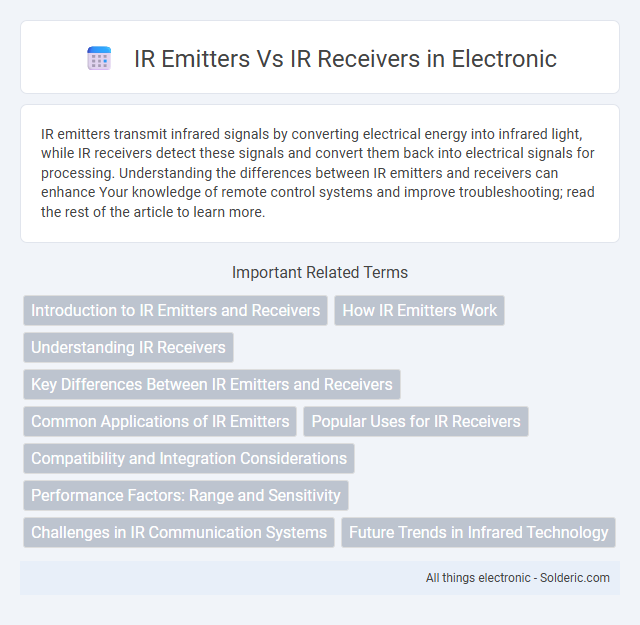IR emitters transmit infrared signals by converting electrical energy into infrared light, while IR receivers detect these signals and convert them back into electrical signals for processing. Understanding the differences between IR emitters and receivers can enhance Your knowledge of remote control systems and improve troubleshooting; read the rest of the article to learn more.
Comparison Table
| Feature | IR Emitters | IR Receivers |
|---|---|---|
| Function | Emit infrared light signals | Detect and receive infrared light signals |
| Common Types | IR LED (Light Emitting Diode) | Photodiodes, phototransistors, IR sensors |
| Wavelength Range | 850 nm to 950 nm | 850 nm to 950 nm |
| Applications | Remote controls, communication, object detection | Remote controls, data reception, proximity sensing |
| Output Signal | Infrared light emission | Electrical signal corresponding to IR light |
| Power Consumption | Typically low, depends on current and voltage | Very low, mostly passive devices |
| Directionality | Directional, needs line-of-sight | Directional or omnidirectional depending on design |
| Examples | Vishay TSAL6200, OSRAM SFH 4059 | Vishay TSOP38238, OSRAM SFH 5110 |
Introduction to IR Emitters and Receivers
IR emitters are devices that generate infrared radiation, typically using light-emitting diodes (LEDs) to transmit signals invisible to the human eye. IR receivers, equipped with photodiodes or phototransistors, detect and convert the infrared signals sent by emitters into electrical signals for processing. These components are essential in remote control systems, obstacle detection, and communication applications, ensuring reliable infrared signal transmission and reception.
How IR Emitters Work
IR emitters function by converting electrical energy into infrared light through semiconductor materials such as gallium arsenide. When current passes through the emitter's diode, it excites electrons that release photons in the infrared spectrum. This emitted IR light serves as a signal for communication or sensing applications, enabling devices to detect or respond to infrared radiation.
Understanding IR Receivers
IR receivers are essential components designed to detect and decode infrared signals emitted by IR emitters, enabling remote control communication in consumer electronics. Unlike IR emitters that generate infrared light, IR receivers contain photodiodes or phototransistors paired with signal processing circuits to filter and interpret modulated infrared signals. Effective understanding of IR receivers involves recognizing their sensitivity ranges, wavelength compatibility (typically around 940 nm), and signal demodulation capabilities to ensure accurate data transfer in applications like TV remotes and sensor systems.
Key Differences Between IR Emitters and Receivers
IR emitters are devices that emit infrared radiation used for transmitting signals, while IR receivers detect and convert this infrared light back into electrical signals. Emitters typically include IR LEDs that produce a focused infrared beam, whereas receivers use photodiodes or phototransistors designed to sense specific IR wavelengths and filter out ambient light. The key difference lies in their function within communication systems: emitters initiate the IR transmission, and receivers interpret the incoming IR signals for processing.
Common Applications of IR Emitters
IR emitters are widely used in remote control systems for televisions, air conditioners, and other consumer electronics, transmitting infrared signals to IR receivers in the devices. You can also find IR emitters in obstacle detection systems, such as those used in robotics and automated doors, where they send out infrared light that is reflected back to receivers to detect presence or movement. In addition, IR emitters serve crucial roles in medical devices for pulse oximetry and non-invasive temperature sensing, where precise infrared light emission is essential for accurate readings.
Popular Uses for IR Receivers
IR receivers are widely used in consumer electronics to detect signals from remote controls, enabling wireless operation of devices such as TVs, air conditioners, and home entertainment systems. These receivers convert infrared light pulses into electrical signals, allowing your electronics to respond to commands from a distance. Their popularity extends to automation systems and security devices, where they facilitate touchless control and monitoring functionalities.
Compatibility and Integration Considerations
IR emitters and IR receivers must be compatible in wavelength and modulation frequency for effective communication in remote control systems. Integration requires careful matching of signal protocols and power specifications to ensure seamless operation across devices such as TVs, set-top boxes, and home automation systems. Proper alignment and calibration enhance IR transmission efficiency, reducing interference and improving overall system reliability.
Performance Factors: Range and Sensitivity
IR emitters and IR receivers differ significantly in range and sensitivity, critical performance factors in optical communication systems. IR emitters, typically LEDs or laser diodes, determine the transmission range by the strength and wavelength of the emitted infrared light, affecting signal propagation distance and obstacle penetration. IR receivers, such as photodiodes or phototransistors, rely on sensitivity to detect low-level IR signals, with parameters like responsivity and noise equivalent power influencing detection accuracy and effective range.
Challenges in IR Communication Systems
Infrared (IR) emitters and receivers face challenges such as signal attenuation, interference from ambient light, and limited range, which impact the reliability of IR communication systems. Your system's performance can be significantly affected by physical obstacles and misalignment between the IR emitter and receiver, causing data loss or decreased efficiency. Designing robust IR communication requires careful selection of components and implementation of error-correction techniques to mitigate these issues.
Future Trends in Infrared Technology
Infrared emitters are evolving with enhanced energy efficiency and higher modulation speeds, enabling faster and more reliable data transmission in wireless communication systems. IR receivers are becoming more sensitive and capable of distinguishing signals from ambient light interference, improving accuracy in applications like gesture recognition and remote control devices. Your future devices will benefit from these advancements, offering improved performance and seamless integration in smart home and IoT environments.
IR emitters vs IR receivers Infographic

 solderic.com
solderic.com